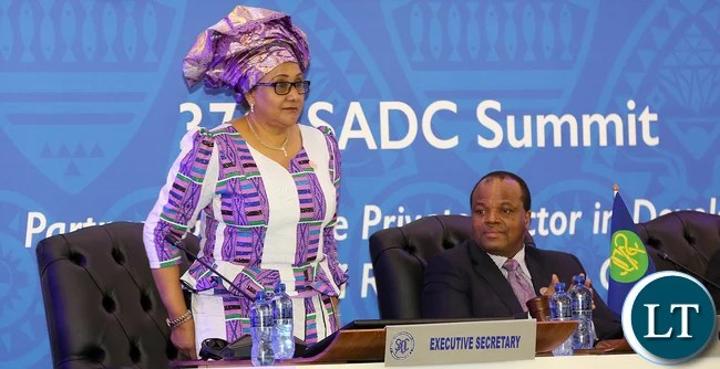
Africa-Press – Zambia. In its pursuit of trade as an engine for economic development, Zambia has a history of overly-underutilizing markets it is member to. Examples include the European Union, the United States, Canada, Japan and even lately, China and India. Albeit free market access, our country’s exports continue to drop instead of rising as Table 1 below shows. Another statistic not shown here shows that in 2001, Zambia ranked number sixteen among the forty-eight Sub-Sahara excluding South African countries in exports of all products to the EU. But in 2020, this ranking dropped to number twenty-seven. Table 1: Zambia’s exports of all products to UK, USA, EU in $ millions 2008 2020 Deficit 92 15 -77 42 34 -7 527 228 -299 Source: Unctadstat
But right in the backyard, Zambia is member of regional trade integration comprising largely COMESA and SADC, the latter perhaps the richest, most qualitative and even quantitative market in Africa because of the presence of South Africa. Just as most progressive countries in the world crave to export to the USA, similar ones in Africa thirst for exporting to South Africa but are thwarted by high import tariffs. But Zambia being member of SADC means it exports to South Africa free of duty for most goods. Do Zambians and their leaders know that to South Africa, Zambia’s exports of all products totaled only $ 181 million in 2020 shown in Table 2 below? While some may jump to concluding that it was due to Covid19, I will ask them to look at data many years prior to Covid 19 in the same Table. In the period shown, Zambia’s highest peak of exports to South Africa was only in 2007 when they reached $494 million. In 2000, Zambia ranked number six in top exporters to South Africa from Sub-Sahara Africa excluding South Africa. However, by 2020 that ranking had slumped to number fifteen, meaning other African countries had overtaken our country and you don’t hear this in Cabinet meetings as if it doesn’t matter.
Table 2: Zambia’s exports of all products to South Africa and SADC in $millions 2006 2007 2008 2009 2010 2016 2017 2018 2019 2020 South Africa 407 494
390
252
435
282
324
361
236
181 SADC 726
1,060
900
777
1,120
1,233
1,272
1,952
1,731
1,948 Source: Unctadstat
Of course, Zambia has key trading partners in SADC other than South Africa with Namibia accounting for 37% and DRC 36% respectively as shown in Table 3 below. In SADC, these three markets including Zimbabwe and Malawi account for 94% of Zambia’s total intra-SADC exports, hence its main markets. It means about ten SADC members are not Zambia’s main export markets. But it is only fair to also say that Zambia’s exports have been rising in SADC in terms of absolute values up to about $2 billion in 2020.
Table 3: Zambia’s main export markets in SADC in proportions 2020 Proportions in total in percentages About $2 billion total exports 37 36 9 Source: Unctadstat
But, is $2 billion exports really Zambia’s potential in a SADC lucrative market with South Africa where our country exports more primary commodities instead of manufactured goods? To Namibia, our country’s main export market in SADC, Zambia’s exports of primary commodities in total account for 99%. So, in the whole SADC market, exports of primary commodities in total account for about 70% with manufactured goods taking the least share of only 30%. To DRC, Zambia exports more manufactured goods than primary commodities in proportional terms but absolute numbers were only $418 million in 2020. And these goods exports comprise mainly sulphuric acids, copper ores and concentrates, non-alcoholic beverages and cement and common things like foods, maize, cane sugar, salts, vegetables, etc. Clearly, Zambia’s focus on the DRC and Namibia and other markets in Africa and divesting from the South African market is largely a result of failure to compete with other African countries in exports of manufactured goods. In 2020, Zambia ranked number eleven in top Sub-Sahara Africa exporters of manufactured goods. Yet, in 2000, its ranking was number six.
In intra-SADC trade, Zambia imports more than it exports leading to trade deficits every year. As an example, in 2020 the deficits in both all products and manufactured goods shown in Table 4 below reached over $1 billion for manufactured goods and almost $1 billion for all products. With trade deficits, the country fails to leverage external revenue from exports leading to shortage of cash for development and it means regional trade is not playing a significant role to help lift Zambians from poverty. I can hence understand why some Zambians are asking why Zambia should not leave some of these regional groupings where it may be reaping more political than economic benefits.
Table 4: Zambia’s intra-SADC trade in $ millions Table 4: Zambia’s intra-SADC trade in $ millions 2020 2,837 1,948 -889 1,724 606 -1,118 Source: Unctadstat
But, despite an awful record in SADC, Zambia has joined the Africa continental free trade area (AfCFTA) to export to the rest of Africa. When I asked a former permanent secretary of the Ministry of Commerce, Trade and Industry in the PF government, why Zambia was entering a larger market before fulfilling the SADC market, her stunning answer was, “If Zambia has liberalized trade with half of Africa (COMESA, SADC and EAC) under the TRIPARTITE arrangement, what’s wrong with doing so with the rest of Africa?” She did not talk about persistent trade deficits. Neither did she mention the products that the country would export to Nigeria, Ghana, Cote D’Ivoire, Morocco, Tunisia, Algeria and other more competitive countries than Zambia with which it currently has no trade partnerships and free trade arrangements.
I conclude by saying that I personally tried to advise government then to focus on building the supply and productive sector; to increase production and industrialization as a matter of priority and forget about looking for more free markets where the country would not export due to lack of products. Industrialization is what Zambia needs. Zambia sometimes should learn to disappoint its fellow African countries by refusing to join groupings that don’t contribute to industrialization. I advised that blind solidarity will not help Zambia to develop. Countries that are developing in Africa are largely those that don’t invest in blind group solidarity, They chose their own national vision and avoid group populism which is often more political than economic.
The African Union is preaching so many things to African member states. So many economic programs are on its website. Yet, it has allowed Viet Nam, a small country in Asia to overtake the whole Africa in exports of manufactured goods. Zambia would do better to build economic partnerships with such countries than responding positively to blind African group solidarity. I advised that when the impact of trade liberalization hits Zambia, the solution for Zambia will not come from the African Union but from Zambia and Zambians. Then solidarity will be ignored. Zambia cannot think that now that it has joined the AfCFTA, then industrialization will be created by these market forces. Viet Nam first built a strong industry which is now producing competitive products, then joined regional trade arrangements. China did not open its trade doors to the world until it developed the supply side.
I hope the new Zambian government will appreciate that group African solidarity cannot be its economic priority. No country in the world developed because of group solidarity. They developed on their own first, then joined groups. Developed countries began by protecting their countries from outside trade, developed then looked for group markets like the World Trade Organization (WTO). Asian countries depend largely on trade with developed countries which is then complemented by intra-Asian trade.
While Africa thinks it can reduce poverty through intra-Africa trade of currently only $70 billion exports, and in future by African countries exporting more to each other, Viet Nam and other Asian continues to increase exports to the rest of the world complimented by almost half inside Asia. Wealth is made by trading with wealth nations. That is what Asan countries do. Because Africa has no industrial products to export, the conclusion by its elite is that the continent has not benefited from trade with rich countries. Asians don’t share that view because they have developed products only wanted by rich countries. Zambia will not develop by trading with DRC, Namibia, Senegal or Benin which are all poor countries without wealth. Zambia should develop its supply side and focus on trading with South Africa and rich countries.
For More News And Analysis About Zambia Follow Africa-Press






